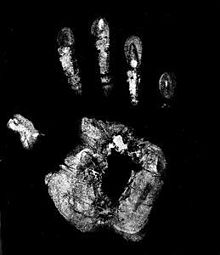Photobatics
Photobatics are a continuation of the chemical charts . Although made with materials found in photography , photobatic is not a photograph . Rather, the chemical properties of developer , fixer and photo paper are used to paint pictures with them in daylight.
Manufacturing
The functional principle is simple: If parts of the photo paper are greased, they cannot react with developer and fixer (grease is water-repellent, the photo chemistry is dissolved in water). So you can “paint” with fat (as with real batik) . The cream is applied to the photo paper with stencils, objects or freehand. Areas that should react with the chemical again can be scratched free with a toothpick, for example.
The most common photobatics is probably the creation of hand and footprints on photo paper: Here the hand or foot is covered with greasy cream and then pressed firmly onto the paper, which is then placed in the developer. Since the fat cream is water-repellent, the print remains white and the rest of the paper turns black. After development, the fatty cream is washed off with detergent and then the image is fixed.
If you want to have a black print on white paper, you must first fix it after you have pressed your hand / foot. Further work steps are watering and removing fat, developing, watering, fixing, final watering.
